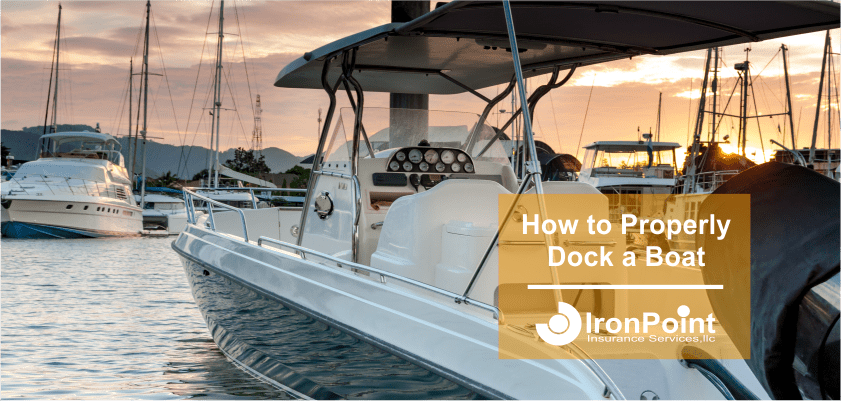How to Dock a Boat Properly and Safely

It’s summer and you’re ready to get out on the water in your new boat. But wait, you’re not fully sure how to dock your boat properly. Well, this is common. Docking a boat in a tricky situation is one of those things that can get your heart racing, and answering that question you had about needing boat insurance.
Don’t worry, docking a boat in most instances is relatively easy. You see it done all the time, the boat pulls into the slip, ties off a few lines, and the boater and family are off. Simple.
Well not so fast, even experienced boaters have had things go sideways when docking. You can likely see a few dings and scrapes on most boats from a wayward docking experience.
So, before you head out on the water or if you just want to brush up, let’s review some important basics to learn how to dock your boat properly. First, get good boat insurance. 🙂 Just kidding!
Here’s what you need to know.
The boat slip versus a dock
Before you can even begin to get familiar with how to dock your boat, you need to know the most common types of docks you’ll encounter on the water. Let’s take a quick review of the slip and the dock:
- Slip: Think of a boat slip like your watercraft’s parking space on the water. Typically, when docking your boat in a slip, you’ll secure it by tying it off on both sides of the dock.
- Dock: Usually “T” shaped, a boat dock or end tie slip only requires that you tie off on the side of the boat facing the dock.
Know the right knots to use
When you safely arrive at a slip or dock, you’ll need to be ready to tie off your boat. The most common knot used when docking your boast will be the cleat hitch. If you haven’t mastered this knot, you need to work on it. Here is a quick video to illustrate how to tie a cleat hitch knot. If you need to tie off to a post or piling, you should also learn the clove hitch knot.
Know the conditions and surroundings
So, you understand the difference between a slip and a dock, and you’re handy with your knots, and time to dock your boat. But there is still one more handy thing to be aware of. Know your surrounding and conditions. Below is a quick list of things that you should be aware of as you approach your slip or dock:
- The weather: The weather is going to play an important role when you dock your boat. It won’t always be clear and calm waters. Is it windy, foggy, or raining? For instance, wind can push your boat and change your approach. The fog can affect visibility. To properly dock your boat you need to fully account for the impact weather will have on your ability to steer or see. This is essential for boating safety.
- Tides or currents: When docking your boast you may need to alter your approach to account for lower tides or tidal push.
- Other boaters: When approaching the dock, make sure to take an inventory of the other boat in the area. It’s important to be aware of other boats on the water as you approach the dock. Most importantly, give everyone plenty of space to avoid close calls – not everyone is the same level of experience.
- Your visibility: Nearly all steering stations have a blind spot. Know what you can and can’t see. If you have a passenger on board, ask them to be your eyes and ears as you approach – especially in the blind areas.
- Can you hear: As you approach the dock, make sure to limit your distractions. Can you hear your passengers or people on the dock? What about people in other boats? Be sure to keep unnecessary noise to a minimum while you’re docking. The fewer distractions, the better.
Be prepared and extra cautious
As you get more experience, docking your boat will be a smooth experience. With that experience, however, you learn to be prepared. Here are some quick notes to help you remain prepared and a bit more cautious.
- Drop those fenders: You don’t intend to bump into anything, but you need to be prepared (it happens). Make sure your fenders are in place before you approach the dock.
- Make sure to communicate: If you have a passenger on board, don’t hesitate to have them give you an extra set of eyes and ears. Even ask them to call out distances from your boat to the dock to help gauge your approach. If you’re solo, don’t be afraid to chat with someone on the dock if you feel you don’t have the proper perspective to gauge distance or speed. The boating community is always happy to lend a hand.
- Make sure your lines are ready: Before you begin your approach, your lines should be ready. In fact, double-check that they’re secured to the boat before you launch and ready (and accessible) to throw or grab as soon as you’re close enough to the dock.
Boat docking safety tips
Sure, there will be some approaches and docks that your use all the time. But even those docking experiences can be a bit different each time. If you don’t have a regular slip or dock, each approach may be different depending on the dock and conditions. But here are some best practices to help you keep it nice and tight:
- Select an approach line: When possible, position your boat so that you can pull straight into the slip or alongside the dock. Don’t try to come in from an angle. If you have to come from an angle, make it as shallow an angle as possible. If the angle is too severe, wait for a better approach line before attempting to dock.
- Slow and steady is good: When docking, speed it not your friend. A basic rule of thumb is to never pull into a dock faster than you’d be willing to hit it. So, once you’ve lined up your approach, pull in slowly and gently.
- You can’t force it: If you lose your line you can’t force the boat into the spot. If you get blown off your line or pulled off course, simply back off and try again. It’s always better to start again than strike another boat or the dock.
- Patience is your friend: When there is a line of people behind you and others watching from the dock, it can be tempting to rush. Don’t! It’s far worse (and more embarrassing) to hit the dock than to back off and reset.
The bottom line
For those new to boating, docking can sometimes be intimidating. Heck, even seasoned boaters find a tough spot to dock from time to time. As you develop more experience you’ll get more comfortable. Soon you’ll be teaching others how to properly dock a boat.
Unfortunately, docking mishaps or other issues on the water are best handled if you have proper insurance. If you need to review your boat insurance coverage, give us a call at (877) 334-7646 or request a quote online.
Get a Boat Insurance Quote

Want to know if you can save on boat or PWC insurance? See for yourself. Start a quote today.
Give us a Ring
Call today and speak with a professional insurance agent.